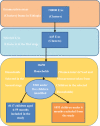Predictors of stunting among children age 6-59 months in Ethiopia using Bayesian multi-level analysis
- PMID: 33580097
- PMCID: PMC7881183
- DOI: 10.1038/s41598-021-82755-7
Predictors of stunting among children age 6-59 months in Ethiopia using Bayesian multi-level analysis
Abstract
In developing countries including Ethiopia stunting remained a major public health burden. It is associated with adverse health consequences, thus, investigating predictors of childhood stunting is crucial to design appropriate strategies to intervene the problem stunting. The study uses data from the Ethiopian Demographic and Health Survey (EDHS) conducted from January 18 to June 27, 2016 in Ethiopia. A total of 8117 children aged 6-59 months were included in the study with a stratified two stage cluster sampling technique. A Bayesian multilevel logistic regression was fitted using Win BUGS version 1.4.3 software to identify predictors of stunting among children age 6-59 months. Adjusted odds ratio (AOR) with 95% credible intervals was used to ascertain the strength and direction of association. In this study, increasing child's age (AOR = 1.022; 95% CrI 1.018-1.026), being a male child (AOR = 1.16; 95%CrI 1.05-1.29), a twin (AOR = 2.55; 95% CrI 1.78-3.56), having fever (AOR = 1.23; 95%CrI 1.02-1.46), having no formal education (AOR = 1.99; 95%CrI 1.28-2.96) and primary education (AOR = 83; 95%CrI 1.19-2.73), birth interval less than 24 months (AOR = 1.40; 95% CrI 1.20-1.61), increasing maternal BMI (AOR = 0.95; 95% CrI 0.93-0.97), and poorest household wealth status (AOR = 1.78; 95% CrI 1.35-2.30) were predictors of childhood stunting at individual level. Similarly, region and type of toilet facility were predictors of childhood stunting at community level. The current study revealed that both individual and community level factors were predictors of childhood stunting in Ethiopia. Thus, more emphasize should be given by the concerned bodies to intervene the problem stunting by improving maternal education, promotion of girl education, improving the economic status of households, promotion of context-specific child feeding practices, improving maternal nutrition education and counseling, and improving sanitation and hygiene practices.
Conflict of interest statement
The authors declare no competing interests.
Figures
Similar articles
-
Determinants of stunting among under-five children in Ethiopia: a multilevel mixed-effects analysis of 2016 Ethiopian demographic and health survey data.BMC Pediatr. 2019 Jun 1;19(1):176. doi: 10.1186/s12887-019-1545-0. BMC Pediatr. 2019. PMID: 31153381 Free PMC article.
-
Levels of stunting associated factors among under-five children in Ethiopia: A multi-level ordinal logistic regression analysis.PLoS One. 2024 Jan 2;19(1):e0296451. doi: 10.1371/journal.pone.0296451. eCollection 2024. PLoS One. 2024. PMID: 38165921 Free PMC article.
-
Severe stunting and its associated factors among children aged 6-59 months in Ethiopia; multilevel ordinal logistic regression model.Ital J Pediatr. 2021 Jul 26;47(1):161. doi: 10.1186/s13052-021-01110-8. Ital J Pediatr. 2021. PMID: 34311750 Free PMC article.
-
Applied nutritional investigation spatial variation and determinants of stunting among children aged less than 5 y in Ethiopia: A spatial and multilevel analysis of Ethiopian Demographic and Health Survey 2019.Nutrition. 2022 Nov-Dec;103-104:111786. doi: 10.1016/j.nut.2022.111786. Epub 2022 Jul 1. Nutrition. 2022. PMID: 35970098 Review.
-
Understanding Stunting: Impact, Causes, and Strategy to Accelerate Stunting Reduction-A Narrative Review.Nutrients. 2025 Apr 29;17(9):1493. doi: 10.3390/nu17091493. Nutrients. 2025. PMID: 40362802 Free PMC article. Review.
Cited by
-
Pooled prevalence of stunting and associated factors among children aged 6-59 months in Sub-Saharan Africa countries: A Bayesian multilevel approach.PLoS One. 2022 Oct 13;17(10):e0275889. doi: 10.1371/journal.pone.0275889. eCollection 2022. PLoS One. 2022. PMID: 36228030 Free PMC article.
-
Social and economic predictors of under-five stunting in Mexico: a comprehensive approach through the XGB model.J Glob Health. 2025 Mar 14;15:04065. doi: 10.7189/jogh.15.04065. J Glob Health. 2025. PMID: 40084528 Free PMC article.
-
The impact of Conditional Cash Transfer program on stunting in under five year's poor children.Public Health Pract (Oxf). 2023 Oct 6;6:100437. doi: 10.1016/j.puhip.2023.100437. eCollection 2023 Dec. Public Health Pract (Oxf). 2023. PMID: 37920185 Free PMC article.
-
Multi-Level Mixed-Effects Analysis of Stunting Among 6 to 59 Months Children in Ethiopia: Evidenced from Analysis of Health and Demographic Survey, 2000 to 2019.Glob Pediatr Health. 2024 Mar 21;11:2333794X241239226. doi: 10.1177/2333794X241239226. eCollection 2024. Glob Pediatr Health. 2024. PMID: 38525434 Free PMC article.
-
Prevalence and Determinants of Undernutrition in Schoolchildren in the Kilombero District, South-Eastern Tanzania.Trop Med Infect Dis. 2024 Apr 25;9(5):96. doi: 10.3390/tropicalmed9050096. Trop Med Infect Dis. 2024. PMID: 38787029 Free PMC article.
References
-
- UNICEF. UNICEF Data:Monitoring the situation of Children and women. Malnutrition, 2018. Retrieved from http://data.unicef.org/nutrition/malnutrition.html.
-
- UNICEF. Stop Stunting: Progress Report 2013–2015. Unicef, 2015. Global Reference List of 100 Core Health Indicators (plus health-related SDGs). Geneva: World Health Organization; 2018. Licence: CC BY-NC-SA 3.0 IGO.
-
- UNICEF/WHO/World Bank. Levels and trends in child malnutrition: UNICEF/WHO/World Bank Group Joint Malnutrition Estimates (2018). 10.1016/S0266-6138(96)90067-4.
-
- IFPRI. Global Nutrition Report 2016: From Promise to Impact: Ending Malnutrition by 2030. International Food Policy Research Institute (IFPRI). 2016.
MeSH terms
LinkOut - more resources
Full Text Sources
Other Literature Sources
Medical
Miscellaneous


